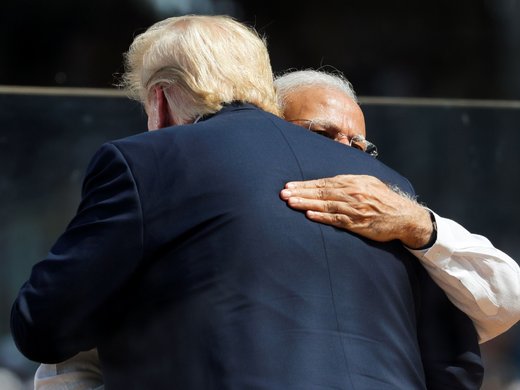The past few weeks have been turbulent for China’s economy, to say the least, with its currency, the renminbi (RMB) — also known as the yuan — declining sharply, nearly two percent against the dollar on August 11, the biggest one-day change in the currency in 20 years. In total, it experienced a 4.4 percent devaluation from August 11 to August 13, shocking the global financial markets. The world interpreted China's move as a currency war or currency manipulation, prompting the devaluation of currencies in many emerging markets. US politicians, ranging from the constant critic of China's currency policy, Democratic Senator Charles Schumer, to a newcomer in the accusation, Republican presidential candidate Donald Trump, joined the barrage to criticize the RMB's devaluation as a way to gain a competitive advantage for China's exports.
China defined the entire scenario in its own way. It rejected the criticism that the move was either a currency manipulation or a currency war. The People’s Bank of China (PBoC) explained its unexpected move was designed to alter the way it sets the initial price (the midpoint price or the central parity) of the RMB against the US dollar. As the PBoC promised, it was an icebreaking step toward a more market-oriented approach to set the RMB’s value, to further promote RMB exchange rate formation mechanisms to reflect supply and demand in the market.
Before the adjustment of August 11, the RMB was under great pressure of falling in the market over concerns of a slowdown in China’s economy and the expectation of a stronger dollar. What the PBoC did on August 11 was to go with the tide, and duly started a significant move on the market-oriented reform on an exchange rate formation mechanism. The PBoC allowed the midpoint price for the RMB to fall two percent, which positioned the central parity of the RMB against the US dollar closer to the actual RMB prices in the market, and made it clear that the PBoC wanted to follow the RMB value set by market forces. Ideally, the PBoC hoped that in the near future, the initial price it set for the RMB would be very close to the closing price the previous day. In that case, the PBoC would no longer need to set the RMB midpoint price and the market would determine the price of the yuan.
However, the PBoC still maintains its great influence on the control of RMB exchange rate for a good reason: the devaluation or appreciation of the yuan on a large scale either way will impact China’s economy and the global economy in a negative way. In the case of devaluation under current circumstances, it would surely bring a large-scale depreciation and higher inflation, as well as add a greater burden for Chinese companies whose debts are mainly denominated in US dollars. It would also cause severe capital flights. For China, the key word “control” must be maintained, with a managed fluctuation being a more appropriate policy option.
The best move the PBoC could take, perhaps, is to push toward a market-oriented currency, without causing dramatic fluctuations. Therefore, measures had to be taken by the PBoC to prevent the yuan from falling further. The PBoC jumped into the currency market to push up the value of yuan when it seemed the RMB would decrease substantially in the two days following the announcement on August 11. In the following two weeks, the PBoC flooded the market with more liquidity to sustain the RMB by declaring a dual cut on the interest rate and reserve requirement ratio, as well as selling more than US$100 billion of reserve assets via open market operations.
Another word, “balance,” reflects why the recent RMB devaluation is controlled within an affordable range by the Chinese government. On the one hand, the adjustment to the yuan’s mid-price helps the PBoC to fulfill its goal to let the market play a bigger role in deciding the price of the yuan and to let it fluctuate in both directions. The move was welcomed by the International Monetary Fund (IMF) and it improved the RMB’s standing at this important international financial body. The allegations of currency manipulation by China, held by some American politicians, were widely promoted to the US public and US Congress. In reality, China’s policy on the RMB exchange rate is far more complicated than “currency manipulation.” Since China began its exchange rate formation reform in 1994, the PBoC has been setting an initial price for the RMB in dollars each morning, and then allowing the currency to trade in a narrow band. The market-oriented reforms on China’s RMB exchange rate formation mechanism have been promoted since 2005. For years, the United States and the IMF have urged China to liberalize its exchange rate and let the market play a more important role in determining the value of its currency. The move by China on August 11 is a significant step toward that goal.
On the other hand, the PBoC is not the only voice in the currency policy-making process in China. It needed to pacify domestic pressure from the export sector. Other considerations on maintaining a stable export market also have a great impact on the policy-making process. The yuan has been rising in strength as the US dollar continues to appreciate over the last year, because it has been loosely, but consistently, pegged with the dollar. The yuan also continues to appreciate against others currencies over the past few years. Consequently, the yuan kept rising against the currencies of China’s main trading competitors and partners, which put China’s export sector in a very disadvantageous condition. That is why China’s State Council had come to the conclusion at the end of July that the currency had to be part of the solution to fix the export problem. The move by the PBoC on August 11 is believed to have taken into account the voice from the export sector and its supervisor, the Ministry of Commerce.
Nevertheless, the surprise move for the two percent yuan devaluation still startled investors around the world and set off huge negative shocks on global stock and commodities markets. Together with the Chinese government’s clumsy, failed intervention to prop up the stock market about a month prior to devaluation, the devaluation was interpreted (mistakenly, some Chinese analysts insisted) by investors around the globe as a sign that the fundamentals of the Chinese economy may be in worse shape than many had thought. As the Shanghai Composite Index dropped 8.5 percent on August 24, the worst single-day loss in more than eight years, followed by another 7.6 percent fall the next day, the worry and panic in the Chinese market transmitted across the world and caused the global financial markets to fall sharply on the same day out of worries about the prospect of China’s economic development.
The negative reaction in the global markets was not what the PBoC expected. China’s explanation on why it had devaluated its currency — i.e., to adjust the yuan’s value to respond more closely to market forces — was taken by global investors as “eyewash” to provide the “political cover for devaluation.” China’s currency policy was introduced based on its leaders’ judgment on its economic fundamentals and a calculation of the policy’s possible political consequences. It is perhaps beyond China’s ability to adequately foresee the spillover effect of its policy making on the global economy, when it introduced the policy in the first place. As a further measure to stabilize confidence in China’s economic growth, the PBoC announced on late August 25 an unusual policy combination to cut the interest rate and banks’ reserve requirements simultaneously, pumping out more liquidity into its bank system, with the intention to counter the ongoing economic slowdown and the shocking stock market selloff. It also declared it would liberalize some deposit rates and give banks more leeway to set deposit rates with a term over one-year deposit, but it would still maintain its control on the one-year benchmark deposit rates.
The steps the PBoC made toward a market-oriented exchange rate and interest rate will enable China to pursue a more traditional monetary policy and maintain a healthy level of economic growth. These measures indicate less direct management and control, as well as more market tools for the PBoC to balance China's economy in coming days. Still, there is a long way to go before China can totally give up the crucial tool — the managed exchange rate — which China believes could keep the effects of global economic turbulences at bay. Whether recent efforts at market-oriented financial reform can bring back the confidence needed to stop the current economic slowdown in China still remains to be seen.


